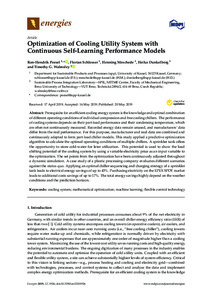View/
Date
2019-05-20Author
Peesel, Ron-HendrikSchlosser, FlorianMeschede, HenningDunkelberg, HeikoWalmsley, Timothy GordonSubject
620 EngineeringMetadata
Show full item record
Aufsatz

Optimization of Cooling Utility System with Continuous Self-Learning Performance Models
Abstract
Prerequisite for an efficient cooling energy system is the knowledge and optimal combination of different operating conditions of individual compression and free cooling chillers. The performance of cooling systems depends on their part-load performance and their condensing temperature, which are often not continuously measured. Recorded energy data remain unused, and manufacturers’ data differ from the real performance. For this purpose, manufacturer and real data are combined and continuously adapted to form part-load chiller models. This study applied a predictive optimization algorithm to calculate the optimal operating conditions of multiple chillers. A sprinkler tank offers the opportunity to store cold-water for later utilization. This potential is used to show the load shifting potential of the cooling system by using a variable electricity price as an input variable to the optimization. The set points from the optimization have been continuously adjusted throughout a dynamic simulation. A case study of a plastic processing company evaluates different scenarios against the status quo. Applying an optimal chiller sequencing and charging strategy of a sprinkler tank leads to electrical energy savings of up to 43%. Purchasing electricity on the EPEX SPOT market leads to additional costs savings of up to 17%. The total energy savings highly depend on the weather conditions and the prediction horizon.
Citation
In: Energies Volume 12 / Issue 10 (2019-05-20) , S. 1926 ; ISSN 1996-1073Sponsorship
Gefördert durch den Publikationsfonds der Universität KasselCitation
@article{doi:10.17170/kobra-20190909661,
author={Peesel, Ron-Hendrik and Schlosser, Florian and Meschede, Henning and Dunkelberg, Heiko and Walmsley, Timothy Gordon},
title={Optimization of Cooling Utility System with Continuous Self-Learning Performance Models},
journal={Energies},
year={2019}
}
0500 Oax 0501 Text $btxt$2rdacontent 0502 Computermedien $bc$2rdacarrier 1100 2019$n2019 1500 1/eng 2050 ##0##http://hdl.handle.net/123456789/11312 3000 Peesel, Ron-Hendrik 3010 Schlosser, Florian 3010 Meschede, Henning 3010 Dunkelberg, Heiko 3010 Walmsley, Timothy Gordon 4000 Optimization of Cooling Utility System with Continuous Self-Learning Performance Models / Peesel, Ron-Hendrik 4030 4060 Online-Ressource 4085 ##0##=u http://nbn-resolving.de/http://hdl.handle.net/123456789/11312=x R 4204 \$dAufsatz 4170 7136 ##0##http://hdl.handle.net/123456789/11312
<resource xsi:schemaLocation="http://datacite.org/schema/kernel-2.2 http://schema.datacite.org/meta/kernel-2.2/metadata.xsd"> 2019-09-10T15:03:23Z 2019-09-10T15:03:23Z 2019-05-20 doi:10.17170/kobra-20190909661 http://hdl.handle.net/123456789/11312 Gefördert durch den Publikationsfonds der Universität Kassel eng Urheberrechtlich geschützt https://rightsstatements.org/page/InC/1.0/ cooling system mathematical optimization machine lerning flexible control technology 620 Optimization of Cooling Utility System with Continuous Self-Learning Performance Models Aufsatz Prerequisite for an efficient cooling energy system is the knowledge and optimal combination of different operating conditions of individual compression and free cooling chillers. The performance of cooling systems depends on their part-load performance and their condensing temperature, which are often not continuously measured. Recorded energy data remain unused, and manufacturers’ data differ from the real performance. For this purpose, manufacturer and real data are combined and continuously adapted to form part-load chiller models. This study applied a predictive optimization algorithm to calculate the optimal operating conditions of multiple chillers. A sprinkler tank offers the opportunity to store cold-water for later utilization. This potential is used to show the load shifting potential of the cooling system by using a variable electricity price as an input variable to the optimization. The set points from the optimization have been continuously adjusted throughout a dynamic simulation. A case study of a plastic processing company evaluates different scenarios against the status quo. Applying an optimal chiller sequencing and charging strategy of a sprinkler tank leads to electrical energy savings of up to 43%. Purchasing electricity on the EPEX SPOT market leads to additional costs savings of up to 17%. The total energy savings highly depend on the weather conditions and the prediction horizon. open access Peesel, Ron-Hendrik Schlosser, Florian Meschede, Henning Dunkelberg, Heiko Walmsley, Timothy Gordon doi:10.3390/en12101926 publishedVersion ISSN 1996-1073 Issue 10 Energies 1926 Volume 12 </resource>
The following license files are associated with this item:
Urheberrechtlich geschützt

